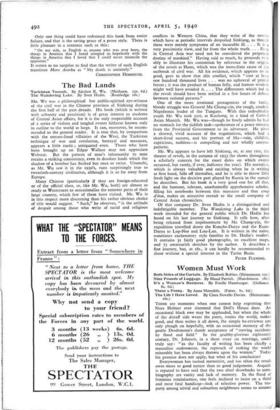The Bad Lands
MR. Wu was a philosophical but public-spirited eye-witness of the civil war in the Chinese province of Sinkiang during the first half of the past decade. His book (which is written with urbanity and precision) is of great interest to students of Central Asian affairs, for it is the only respectable account of a series of violent and tangled events hitherto known only in outline to the world at large. It can, moreover, be recom- mended to the general reader. It is true that, by comparison with the stream-lined villainies of the West, the Turkistan technique of war and revolution, betrayal and massacre, appears a little rustic ; antiquated even. Those who have been brought up on Edgar Wallace may not appreciate Webster. But the pattern of man's inhumanity to man retains a striking consistency, even in desolate lands which the shadow of a bomber has flecked but once or twice. Urumchi, as Mr. Wu saw it in the 1930's, runs surprisingly true to twentieth-century civilisation, although it is so far away from Europe.
Many Chinese (particularly if they are foreign-educated or of the official class, or, like Mr. Wu, both) are almost as ready as Westerners to sensationalise the remoter parts of their large country, which few of them have visited. Mr. Wu is in this respect more discerning than his rather obvious choice of title would suggest. " Such," he observes, " is the attitude of despair among those who write of racial and religious conflicts in Western China, that they write of the revo.:s which have at periodic intervals despoiled Sinkiang, as thou .h these were merely symptoms of an incurable ill. . . . It is a
very pessimistic view, and far from the whole truth. . . . ri in Central Asia war need not be considered the perpeti. tl destiny of mankind." Having said as much, he proceeds v(..v ably to illustrate his contention by reference to the origins of the revolt at Hami, which was the immediate cause of tl.e outbreak of civil war. All his evidence, which appears to 3e good, goes to show that this conflict, which " cost at let one hundred thousand lives . . . was no upheaval of primal forces ; it was the product of human folly, and human wisdom might well have avoided it. . . . The differences which led io the revolt should have been settled in a few hours of debate between rational persons."
One of the more irrational protagonists of the futile, bloody struggle was General Ma Chung-yin, the tough, crude.y Napoleonic leader of the Tungans. With this redoubtable youth Mr. Wu took part, at Kucheng, in a kind of Central Asian Munich. Mr. Wu was—though he freely admits he had no stomach for the ticklish task—spokesman of a peace mission from the Provincial Government to its adversary. He gives a shrewd, vivid account of the negotiations, which had a short-lived success, and his portrait of Ma—vain, childish, capricious, ruthless—is compelling and not wholly unsym- pathetic.
Mr. Wu appears to have left Sinkiang, or, at any rate, the theatre of revolt, in the autumn of 1933 (he shows throughout a scholarly concern for the exact dates on which events occurred, but rarely, if ever, indicates the year). His narrative, which is always valuable and exciting when he is writing at first hand, falls off thereafter, and he is able to throw little fresh light on the decisive part played by Russia in the tumult he describes. But his book is a very good one for all that, and the humane, tolerant, unashamedly apprehensive scholar, filling his notebooks between this massacre and that coup d'etat, makes an attractive recruit to the small company of Central Asian chroniclers.
Of that company Dr. Sven Hedin is a distinguished and indefatigable member. The Wandering Lake is the third work intended for the general public which Dr. Hedin has based on his last journey to Sinkiang. It tells how, after being released from imprisonment by Ma Chung-yin, the expedition travelled down the Konche-Darya and the Kum- Darya to Lop-Nor and Lou-Lan. It is written in the naive, sometimes exclamatory style familiar to Dr. Hedin's readers. It contains 31 fairly good photographs, ro excellent maps, and 75 amateurish sketches by the author. It describes a fine journey, but, at 18s., it can hardly be recommended to those without a special interest in the Tarim Basin.
PETER FLEMING.














































 Previous page
Previous page